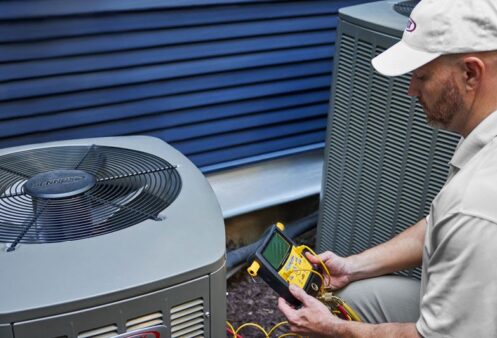Maintaining a functional heating system ensures a comfortable environment during cold seasons. Recognizing the signs that a heating system needs repair can save money and prevent significant damage. Here are the top signs to look out for, so you can get help as soon as possible.
Unusual Noises
Noticing your heating system emitting peculiar sounds is cause for concern. Hearing clanging, squealing, or even intermittent banging signifies underlying issues. These unfamiliar sounds can stem from various components, such as belts or motors malfunctioning. It’s crucial to consult a professional when these noises persist. Immediate attention can prevent more significant issues, ensuring your system operates efficiently. It’s always better to identify and rectify these disturbances early. Letting them persist might lead to costlier repairs in the future. Remember, a quiet system is typically a healthy one. So, any deviation from the norm suggests a potential problem.
Inefficient Temperature Distribution
When certain areas in your home feel noticeably cooler or warmer, it’s often an indication that your heating system is not functioning optimally. Regular maintenance can prevent such issues, ensuring a consistent temperature throughout your home. An efficiently working heating system not only provides comfort but also saves on energy bills. It’s essential to address these inconsistencies promptly for optimal performance. If these issues persist, seeking professional help is recommended. Proper care and timely repairs ensure the longevity and effectiveness of your heating system.
Increased Heating Bills
Are you noticing your energy bills climbing higher than usual? This could indicate that your heating system’s efficiency has decreased. It may be struggling to maintain temperatures or using more power than necessary. Over time, various components can wear out, causing the system to work harder. Monitoring monthly bills for sudden spikes can alert homeowners to potential heating system issues. When your heater starts consuming more energy, it’s often a red flag. Addressing these inefficiencies promptly ensures a comfortable living environment and avoids further complications. It’s essential to stay vigilant and recognize such signs early on.
Yellow Pilot Light
A gas-powered furnace pilot light is an essential component for its operation. Typically, it emits a blue flame, representing optimal function. A shift from blue to yellow is alarming and requires attention. This color change can signify that the furnace might be releasing carbon monoxide, a dangerous gas. Monitoring the pilot light ensures safety and helps to identify early signs of issues. Carbon monoxide poses health risks, making it vital to address a yellow pilot light immediately. Regularly checking this component can prevent potential hazards and ensure a safer environment in your home. Recognizing these changes can be the key to maintaining a healthy living space.
Reduced Air Quality
When your home’s atmosphere begins to change, and you start to feel the presence of more dust or experience dry air, it can be an indication that your heating system might not be operating at its best. Heating systems play a pivotal role in ensuring the air quality of your indoor environment is optimal. Dust particles, allergens, and other airborne irritants can get trapped inside, affecting the overall air quality. When the system’s filtering mechanism becomes compromised, these particles find their way into your living space, leading to potential respiratory issues and discomfort. This deterioration in air quality is more than just an inconvenience; it’s a clear signal that the heating system is not functioning as it should.
Frequent On and Off
If your heating system turns on and off erratically, this behavior can be due to various reasons. One prime suspect behind this inconsistency is the thermostat. It acts as the control panel of the heating system, dictating when it should be operational. If it starts misreading room temperatures or fails to send the correct signals to the system, you’ll notice the heating system operating intermittently. Such frequent disruptions not only affect your comfort but can also strain the system, leading to potential long-term damage.
Constant Blowing
Every homeowner expects their heating system to perform efficiently, providing warmth, especially during the colder months. An efficient working system should evenly distribute warm air throughout the home and cease its operation once the desired room temperature is attained. However, when the system begins to blow cold air or continuously runs without providing heat, it’s an obvious red flag.
This constant blowing could be due to several reasons. One possibility is a malfunctioning thermostat, which isn’t signaling the system to stop after reaching the desired temperature. Another potential cause could be compromised system components, hindering the equipment from operating smoothly.
Water Leaks
Water leaks around a furnace or heating system are hard to ignore and are a strong indication of an internal problem. Typically, during its operation, a heating system condenses air. This condensed moisture is then meant to be drained away efficiently, ensuring no water buildup. However, when you begin to observe water pooling around your furnace, it’s often a sign of a faulty condensation drainage system. Such malfunctions can escalate to a series of issues including potential mold growth, rusting of crucial furnace components, or even structural damage to your home. Moreover, this pooling water can pose a slip hazard, emphasizing the need to address this sign promptly.
Bad Odors
If you turn on your heating system and are met with an unpleasant, musty odor, there is an issue with your heating system. Such an occurrence is not only off-putting but can also signal potential mold or mildew buildup within the system. Mold growth is problematic, posing health risks, especially for those with allergies or respiratory conditions. If it’s a burning smell you detect, it’s even more alarming. Persistent burning odors could indicate electrical malfunctions, possibly involving wiring issues or overheating components.
Old Age
As heating systems age, they become more susceptible to a range of problems. If your heating system is over 15 years old, it’s likely to experience decreased efficiency and an increased likelihood of malfunctions. The components within the system can wear down over time, leading to issues such as reduced heat output, uneven heating, and higher energy bills. Regular maintenance checks become crucial to catch these problems early and keep the system running smoothly.
Difficulty Starting
A heating system that struggles to start or fails to start altogether is a clear indicator that something is amiss. This issue could stem from various causes, including faulty ignition systems, worn-out components, or fuel delivery problems. Ignoring these symptoms may lead to a complete system breakdown, leaving you without heat during the coldest times. If your heating system exhibits difficulty starting, it’s important to address the problem promptly to prevent further deterioration.
Thermostat Issues
Constantly adjusting the thermostat to maintain a comfortable temperature indicates that your heating system isn’t functioning efficiently. An inefficient heating system not only compromises your comfort but also strains your energy consumption, leading to higher utility bills.
Contact Us Today
At Laury Heating Cooling & Plumbing in Pennsville, New Jersey, we provide heating repairs, heating installation, and ductless heating services for your home. Our friendly team also provides plumbing, AC services, and natural gas conversions. Contact Laury Heating Cooling & Plumbing for more information on our heating services today.



